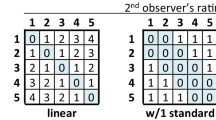Abstract
In calculations of the discriminating-power parameter of the normal ogive model, Bock and Lieberman compared estimates derived from their maximum-likelihood solution with those derived from the heuristic solution. The two sets of estimates were in excellent agreement provided the heuristic solution used accurate tetrachoric correlation coefficients. Three computer methods for the calculation of the tetrachoric correlation were examined for accuracy and speed. The routine by Saunders was identified as an acceptably accurate method for calculating the tetrachoric correlation coefficient.
Similar content being viewed by others
References
Abramowitz, M., & Stegun, I. (Eds.),Handbook of mathematical functions. Washington, D. C.: U. S. Government Printing Office, 1967. pp. 966–970.
Bock, R. D., & Lieberman, M., Fitting a response model forn dichotomous items.Psychometrika, 1970. (In press)
Buhler, R., Tetrachoric program inP-stat, version 45 source listing. (Generated from P-stat program tape at The University of Chicago Computation Center, May 17, 1968). pp. 143–148.
Carroll, J. B., The nature of the data or how to choose a correlation coefficient.Psychometrika, 1961,26, 47–372.
Castellan, N., On the estimation of the tetrachoric correlation coefficient.Psychometrika, 1966,31, 67–73.
Castellan, N., & Link, S., Tetrachoric correlation program for the IBM 709/7090.Behavioral Science, 1964,9, 292.
Charap, M., Tetrachoric correlation. (An Educational Testing Service program write-up, dated December 1957).
Kuki, H.,Mathematical functions. (The University of Chicago Computation Center report, 1966). p. 103.
Owen, D., Tables for computing bivariate normal probabilities.The Annals of Mathematical Statistics, 1956,27, 1075–1090.
Pearson, K., Mathematical contributions to the theory of evolution. VII: On the correlation of characters not quantitatively measurable.Philosophical Transactions of the Royal Society, London, 1901,195A, 1–47.
Tucker, L.,Notes on the approximation of tetrachoric correlation. (Unpublished notes, dated April 4, 1960).
U. S. Bureau of Standards,Tables of the bivariate normal distribution function and related functions. Washington, D. C.: U. S. Government Printing Office, 1956. (Applied Math Series No. 50).
Author information
Authors and Affiliations
Additional information
This research was supported in part by NSF Grant E 1930 to The University of Chicago. The author wishes to thank Dr. David R. Saunders and Dr. Ledyard Tucker for the use of their original materials and Dr. R. Darrell Bock for his many helpful suggestions and his ready counsel throughout the course of this investigation.
Rights and permissions
About this article
Cite this article
Froemel, E.C. A comparison of computer routines for the calculation of the tetrachoric correlation coefficient. Psychometrika 36, 165–174 (1971). https://doi.org/10.1007/BF02291396
Received:
Revised:
Issue Date:
DOI: https://doi.org/10.1007/BF02291396




